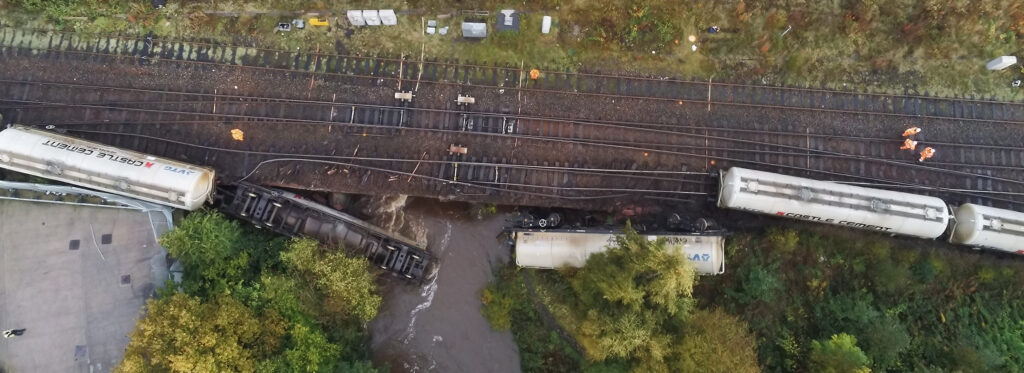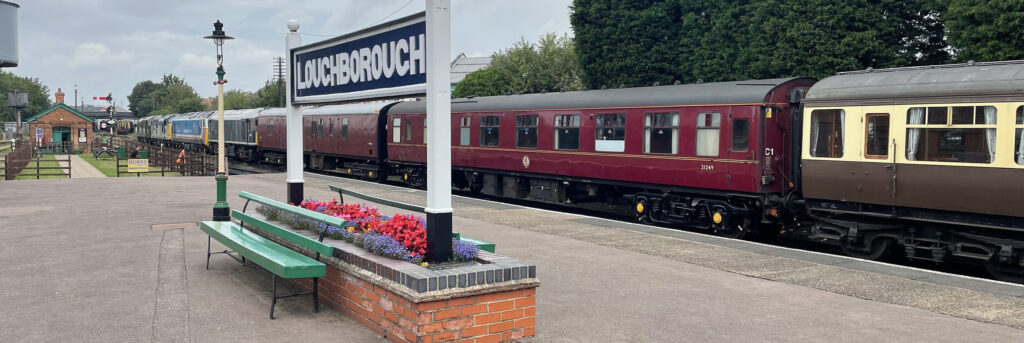Colin Wheeler
Colin Wheeler gives us a roundup of the latest safety reports from the Rail Accident Investigation Board (RAIB).
Calendar year 2023 looks like being a bumper year for RAIB reports. Report number 12/2023 was issued on 24 October. It is a comprehensive report of an accident that occurred two years ago on 31 October 2021. The thorough nature of the report is outstanding, and its findings and recommendations are significant.
The accident was a collision between two passenger trains at Salisbury Tunnel Junction. On that day, the 17:20 South Western passenger service from London Waterloo to Honiton passed a red signal and collided with the side of the 17:08 Portsmouth Harbour to Bristol Temple Meads passenger train. The Honiton train was travelling at 52mph and the Bristol Temple Meads train at 20mph. Their collision at Salisbury Tunnel Junction came to a halt in Fisherton Tunnel. A railway staff member and thirteen passengers needed hospital treatment.
The investigation found that rail/wheel adhesion was very low in the area that day due to leaf fall, among other things, and the train driver did not apply brakes sufficiently early on the train’s approach to the protecting signal. The impact between the two trains caused the front two carriages of the Honiton train and the rear two carriages of the Bristol train to derail. Both trains ran on together before coming to rest in Fisherton Tunnel. The investigation also found that just a minute earlier there was the potential for the Honiton train to have been involved in a head-on collision with a train travelling in the opposite direction.
The report also says a probable underlying factor was that Network Rail’s Wessex Route, “Did not effectively manage the risks of low adhesion associated with the leaf fall season.” Following a review of practices, training, and briefings, Network Rail and South Western Trains have jointly updated their annual autumn leaf fall arrangements.
Also, the Rail Safety and Standards (RSSB) has revised its standard providing guidance to the industry on managing low adhesion. The Office of Rail and Road (ORR) issued an improvement notice in December 2021 requiring Wessex Route to improve its vegetation management.
In total, the RAIB’s report makes 10 recommendations. Two years is a long time to wait for the report, but clearly many players in the industry have been directly involved and the 10 recommendations will surely be of benefit to everyone.
Freight train derailment at Petteril Bridge Junction
It has been announced that the European Commission has made three new proposals for improving rail freight which aim to increase rail freight by 50% by 2030 and double it by 2050. Europe is taking the view that a switch to rail is better for the environment, will assist in their initiatives to reduce carbon emissions, and arguably this should reduce the costs and the risks arising from rail freight accidents and incidents. But will the objectives be achieved? It is better for the environment, but RAIB reports have all too often identified wagon maintenance and defects as the root cause of derailments.
On 19 October 2022, at 19:53, five tank wagons in a freight train that was conveying cement powder from Clitheroe, Lancashire, to Mossend, near Glasgow, derailed near Petteril Bridge Junction in Carlisle. The freight train derailed due to the wheels of the ninth wagon having stopped rotating. RAIB report 10/2023 says that the wheels may have stopped turning up to 55 miles before the derailment, but makes no reference to track damage.
The sliding wheels resulted in damage to the wheel treads resulting in derailment. This was probably the cause of the trains failure to negotiate a set of points located just before Petteril Bridge Junction.

Five wagons derailed and two fell off the side of the bridge which carries the railway over the River Petteril. The ninth wagon fell from the bridge, landed upside down and ruptured in the river!
The reports says that the wheel slide “was probably the result of a normal brake application”. Non-rotating wheels were not identified by signallers on the route or the train driver or any engineering system. RAIB report’s first recommendation is “For the industry to work to understand the risks to freight trains in low adhesion conditions.”
Two further recommendations call for a Rule Book review of requirements for stopping and examining trains and for “drivers looking back along their trains.” A learning point is for signallers to be reminded of “the circumstances in which they should stop trains for examination.”
Wires crossed at South Wingfield
On October 23, RAIB report 11/2023 was published following an incident at South Wingfield which involved a train travelling between Derby and Chesterfield. The incident occurred at 07:02 on 26 October 2022. The train, which was travelling at 100mph, unexpectedly encountered a signal displaying a red signal and was unable to stop. It passed the signal by about 750 metres and the driver called the signaller right away. Seventeen minutes later, the following train approached the signal which was by then showing a caution yellow aspect. After passing that signal the second train stopped about 75 metres behind the first, with both trains in the same signalling section. Having obtained the signallers permission, both continued their journeys.
RAIB’s report says that the incorrect signalling aspects were due to red and yellow aspect wires being crossed in a nearby equipment cabinet. The cables had been disconnected and then reconnected during engineering work the previous night. This had not been identified when the signal was tested after work was done. The report says that “testing was affected by a combination of time pressure, tester workload, and possibly by unfamiliarity with the configuration of the signalling equipment.”
The report adds that “Network Rail had taken steps to assure signal maintenance testing was carried out by its own staff but had not yet included testers employed by contractors.” It says that “no one was carrying out any signalling related assurance activities when this sort of work was taking place.”

RAIB noted that the action of signallers at the East Midlands Control Centre reduced the potential for a collision.
Four issues with testing work were observed by RAIB. These included test records, tester licensing, drawing deficiencies, and the omission of tests the previous night. The report also observes that whilst initial checks were carried out for both drivers, only one received post-incident welfare checks. Five recommendations are made. One calls for the enhancement of effective communicating, safe decision making and behaviours when working under time pressure; another addresses better management of lead testers workloads. The fourth is for Network Rail to ensure contractors maintenance testing is of the required standard and the fifth requires them “to provide testers with a means of recording the test steps when a signal’s aspects are tested.”
Additionally, six learning points are listed. They are: the importance of signalling testers following process; ensuring managers and supervisors do not exert pressure even when work is overrunning; the third and fourth stress the importance of communication between drivers and signallers; fifth is a reminder about signalling equipment including track circuits being tested; the sixth is a reminder to follow up post incident checks with all drivers involved in a signalling irregularity.
Another signal passed at danger
On 22 August this year a signal was passed at danger at Stafford Trent Valley No 1 Junction. At 16:42 a Freightliner locomotive on a test run between Nuneaton and Crewe passed a signal at danger (red) on the approach to the junction. It ran through the points and came to a stand at the junction where its position conflicted with the route set for another train. The locomotive did not derail, no-one was injured but damage was caused to the points. Another RAIB investigation is underway.
Loughborough Central Station accident
At 11:50 on Saturday 14 January 2023, a passenger alighting from a train at Great Central Railway’s Loughborough Central station fell onto a platform ramp and was seriously injured. The partially sighted man was unable to negotiate the step down onto the platform ramp. The platform was a mere two metres longer than the minimum distance needed to accommodate all the train doors. On that day “the train’s brakes were not performing in a consistent, predictable manner.” Measures implemented “had not controlled the risk of passengers using doors which were not adjacent to usable platforms.” The report also states that the Great Central Railway did not have effective processes for learning lessons from operational experience or any to support the identification, management, and monitoring of risk.
The report makes three recommendations. First, Great Central Railway is to assess and control risk, learn from previous events, and ensure the needs of disabled passengers are considered. The second recommendation relates to auditing and assurance of risk management activities. The third is for the Heritage Railway Association, recommending “the provision of guidance on managing risks around the passenger / train interface at heritage railway stations.”

Member of staff struck by train in Bristol Depot
On 26 September, at St Philips Depot Bristol, a member of staff was struck by a train. The individual was responsible for shunting trains and was struck by one which had just left the main shed. The individual sustained serious injuries to the lower body, minor injuries to the upper body, and head injuries.
The RAIB investigation will look at the sequence of events, the actions of those involved, processes for train movements, training and competences of staff, depot train movement management, and underlying management factors.
Flying Scotsman collision
RAIB is also investigating the Strathspey Railway accident which occurred on 29 September at Aviemore station. Around 18:05 the Flying Scotsman steam locomotive collided with a set of passengers coaches at 7mph. Injuries were sustained by passengers and Strathspey staff but only one passenger and one staff member needed hospital treatment. There was no derailment but vehicles were damaged. RAIB’s investigation will include the management of staff involved, policies and procedures, injuries, damage caused, and underlying management factors.
Image credit: RAIB

